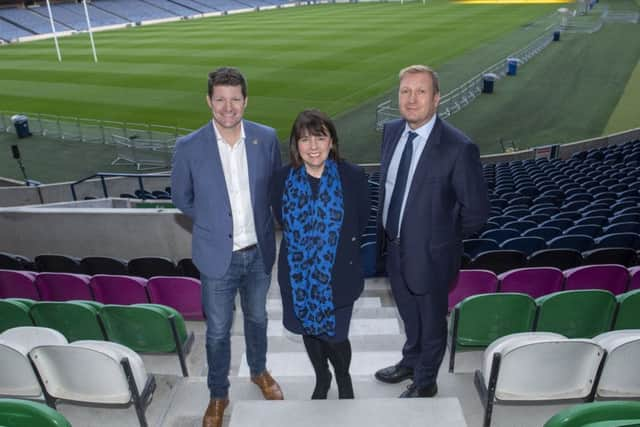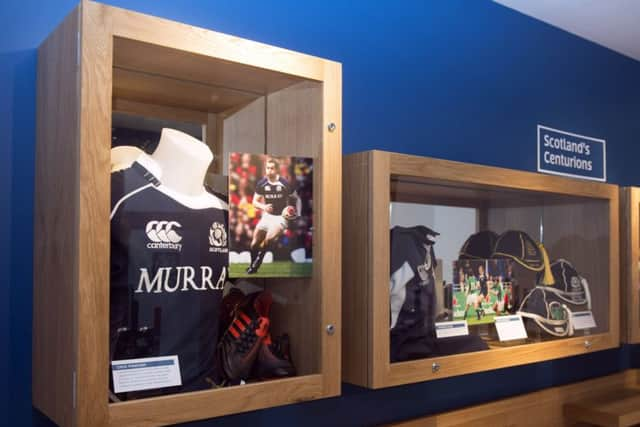Multi-million project opens up new suites at Murrayfield Stadium
The venue, which has hosted Scottish rugby for almost one hundred years, has just refurbished its 1925 suites aimed at boosting corporate visits to Murrayfield.
The multi-million pound project, partly financed by a seven-figure cash injection from hospitality partner Elior, is just part of a feeling of regeneration which has pervaded the sport at its Edinburgh home.
Advertisement
Hide AdAdvertisement
Hide AdAlthough the new suites have a slightly smaller capacity than their previous incarnation, their offering is “better quality” – meaning more bookings and higher prices.


Bookings are already flocking in, not just for match-day hospitality events, but for conferences and other events.
However, the clientele has adapted since the recession of the late 2000s, when financial companies and oil industry professionals which had previously been the venue’s hospitality bread and butter were forced to tighten their belts as the financial crash deepened.
“Construction companies are now our biggest market,” explained Fi Morley, venue director. “Construction companies, contractors of construction companies, we see them here a lot.
“Edinburgh and Scotland in general is booming in terms of construction growth. You can see it from the cranes all over the place and we see it here too.”


On the day two weeks ago that the first of the suites reopened after a five-month break, the hospitality team hosted a conference for 600 delegates. “The demand is so high, we can hardly get everyone round who wants to see it,” added Morley.
The stadium has recently agreed a five-year extension to the existing agreement with hospitality provider Elior, which will take the partnership through to 2031 – 22 years since its inception.
The majority of the profit generated from all activities in the Elior partnership is invested back into the game of rugby through a contracted profit share arrangement.
Advertisement
Hide AdAdvertisement
Hide AdRevenue was up to £62 million at Scottish Rugby last year – more than double the £30m achieved in 2011 – generated by ticket sales and hospitality, including outside events using the stadium, such as the sell-out Spice Girls concert in June, as well as TV revenue for screening games.
The new revenue streams are welcome.
Financial issues at Scottish Rugby have plagued the sport for more than a decade – in 2005 rugby officials were first forced to ask the then-Scottish Executive for financial assistance.
Now, with Murrayfield’s centenary looming in 2025, it appears that the game has finally turned around its financial fortunes.
Earlier this year, Scottish Rugby declared its balance sheets to be debt-free for the first time in 20 years.
Speaking at a post-AGM press conference earlier this year, chief executive Mark Dodson told reporters that he had reduced debt dramatically in his eight-year tenure.
He said: “Every year, and for the last 20 years, we’ve looked at our net cash position and that’s what we’ve always classed as where we are going to be from debt free. It was £23 m at its highest peak, when I came it was £14.4m and now it is zero.”
The new suites, named to honour Scottish Rugby’s history, offer a dramatic view over the pitch from the largest Centenary Club suite through a glass door.
Dominic McKay, chief operating officer at Scottish Rugby, admitted that the historic stadium had to adapt to catch up with other international venues.
Advertisement
Hide AdAdvertisement
Hide Ad“Most stadiums are built with boxes all the way around with a view out on to the pitch,” he said. “This is quality growth.”
While there is still some demand for the more formal sit-down hospitality meal, McKay said that a lot of customers were looking for something more informal.
“They might want to have a light bite to eat, watch the match, have a drink and then another light bite,” he said. “These new suites give us the ability to offer that flexibility.”
Around one in five match day ticket sales are through hospitality, with many people making a day of it in the hospitality suite.
“The joy of a big match like the Six Nations is people come in the morning, have a drink, maybe watch another match on TV and then enjoy the game,” he said. “And we’re able to use the stadium more for outside events such as concerts because of the investment we’re making. Each of these events beings with it an opportunity to drive hospitality.”
As a result of a revamp of the offerings in the new suites, the corporate visitors are offered not just the chance to hobnob with rugby players, but a live Skype bradcast of the team getting on to the bus from their hotel.
“You don’t get much more behind-the-scenes than that,” said Natalie Lovegrove, head of hospitality sales at Murrayfield.
Lovegrove said the increase in hospitality had coincided with an improvement in the performance of Scotland’s national team, which in turn, fuelled demand for socialising around the games.
Advertisement
Hide AdAdvertisement
Hide Ad“Things have changed massively over the past few years,” she said. “There was a time when you were pleased if Scotland scored a try, but now it’s more about can we win games? The team is playing exciting rugby.
“It makes my job a lot easier.”
Further investment is planned, although rugby officials are insistent that the more dramatic proposals to eventually demolish the East Stand and replace it with a new seating area with hospitality built in are “seriously long term”.
In fact, these grand plans are believed to be predicated on private equity funding coming into the Six Nations championship.
It emerged last week that the Six Nations has “entered into an exclusive period of negotiation” with private equity firm CVC to sell a stake in the game’s oldest championship. The deal has been controversial as it would provide a financial boost to each union, but would mean partly surrendering control of the competition.
In addition, a new purpose-built 7,800-seater stadium is finally set to be built on the grounds’ back pitches to house Edinburgh Rugby – who have been rattling around the main stadium for years – as well as other sporting events and concerts.
It had been hoped the arena would be ready in time for the start of this season, which began on Saturday when Edinburgh hosted Zebre, but construction was delayed amind a planning wrangle. Work is now expected to start next month.
Scottish Rugby is planning an economic impact assessment to ascertain how much money the organisation generates for the wider Scottish economy.
“We did it a number of years ago and it was £110m,” said McKay. “Now, it will be far higher. There are very few organisations that bring that level of sport with that quality of high level spend into the city.”